 Last Updated February 9, 2025
Last Updated February 9, 2025
The most common Vitamix shopper’s question is some variant of, “I want to make smoothies, soups, and frozen desserts. Which Vitamix blender is best for me?” The answer is that all Vitamix machines work great for those tasks; which one is best depends on the volumes you want to blend and whether you want to pay for extra features.
If you don’t want to go through the nitty-gritty, here are my quick Vitamix recommendations:
Which is the best Vitamix model?
Best Value
- E310 (short/narrow container for small to medium amounts)
- Recon 5200 (tall/narrow container for small to large amounts)
- Recon E320 (short/wide container for medium to large amounts)
Money Is No Object
- Ascent X5 (latest and greatest)
The February 2025 shopping landscape
Most Vitamix models are on sale through Feb 22nd for the President’s Day Sale. Here is the sale.
Vitamix recently released a new set of Ascent models. Full details are in my Vitamix Ascent X Series Review.
The Food Processor Attachment gives more reason to consider Ascent and Venturist models, since it is not compatible with classic models. If you don’t care about the premium finish of the A3500, consider saving big on the Reconditioned Venturist.
If you are looking for the lowest possible price, I recommend choosing between the Recon 5200, the E310, and the Recon E320. The most significant difference between these models is the container they come with, so use the following Venn diagram to pick the optimal container for you. There are trade-offs between the three container options. To put it briefly, “short, narrow, or large capacity: pick 2”: 
Note to visitors from outside the United States: The model availability described on this page is for the USA (and APO/FPO addresses). If you are shopping from Canada, check out my page about Canadian Vitamix models.
For most people, I recommend choosing from the following four categories: Certified Reconditioned models, Explorian, Premium Classic, and Ascent.
Reconditioned
 If you are looking for the lowest possible price on Vitamix, reconditioned is for you. Some people are hesitant to buy reconditioned, and that is a valid concern with some companies, but Vitamix’s reconditioned units are guaranteed to be top quality. The only reasons I would avoid reconditioned Vitamix are if it is for a gift for someone who won’t understand, or if you want some of the features not available on reconditioned machines.
If you are looking for the lowest possible price on Vitamix, reconditioned is for you. Some people are hesitant to buy reconditioned, and that is a valid concern with some companies, but Vitamix’s reconditioned units are guaranteed to be top quality. The only reasons I would avoid reconditioned Vitamix are if it is for a gift for someone who won’t understand, or if you want some of the features not available on reconditioned machines.
Explorian
 If you prefer a slightly smaller container, I highly recommend the new E310, which comes with a short and narrow 48-oz container (full review). The Explorian E320 is functionally identical to the E310, but it comes with a wide container. That makes it nearly identical to the 5300. (The E320 replaces the 5300 in the model lineup, and it is mostly the same, with a few changes: it does not have the on-off switch on the side, and it does not light up when on. I don’t think these differences matter much, but there they are for anyone wondering about E320 vs. 5300.)
If you prefer a slightly smaller container, I highly recommend the new E310, which comes with a short and narrow 48-oz container (full review). The Explorian E320 is functionally identical to the E310, but it comes with a wide container. That makes it nearly identical to the 5300. (The E320 replaces the 5300 in the model lineup, and it is mostly the same, with a few changes: it does not have the on-off switch on the side, and it does not light up when on. I don’t think these differences matter much, but there they are for anyone wondering about E320 vs. 5300.)
There is now also an Explorian E520, which comes with the wide 64-oz container and adds 3 preset blending modes. With the hidden discount that gets activated after clicking a Vitamix link on this site and then adding the Recon E520 to your shopping cart, it is an excellent deal.
Premium Classic and Propel
If you want the most premium machine, but don’t want the new technology of Ascent, then the Professional Series 750 is for you. I think the Ascent machines are quite nice, but you might not like the look of their digital display, or you might want to be able to use older containers (without NFC chips).
In 2023 Vitamix released a new Series, which they are calling the Propel. Similar to the Pro 750, these machines have preset modes and a secondary on-off switch. The Propel machines also have the subtly updated styling that was released with the Explorian series: Propel 510 and Propel 750.
Ascent (Smart System Blenders)
If you want to buy into the future of Vitamix, the Ascent Series is the way to go. It’s priced in the same range as new Legacy models, but it comes with various upgrades (among them: longer warranty, timer display, can use small cups without bulky adapter, and a wireless connection to smartphone app).

 Within the Ascent Series, the A2300 is the lowest-priced model and it has everything you need. (If you’re buying reconditioned, the A2500 is the lowest-priced model, and it has all the features of the A2300, including full variable speed control, and it adds 3 preset program modes.) If you feel like upgrading, I recommend going all the way up to the A3500, because it has premium finish options. (I’m not saying that the intermediate Ascent models are a bad choice, they just wouldn’t be my choice.) See my Ascent review page for more details.
Within the Ascent Series, the A2300 is the lowest-priced model and it has everything you need. (If you’re buying reconditioned, the A2500 is the lowest-priced model, and it has all the features of the A2300, including full variable speed control, and it adds 3 preset program modes.) If you feel like upgrading, I recommend going all the way up to the A3500, because it has premium finish options. (I’m not saying that the intermediate Ascent models are a bad choice, they just wouldn’t be my choice.) See my Ascent review page for more details.
If you’ve been putting off getting a Vitamix because you’re saving up, you can get one right away with a payment plan. If you make on-time payments, there are zero financing fees.
You can leave a comment below or contact me if you are still having trouble deciding which one to get.
Comparison of pre-Ascent models follows
If you want to quickly see the relation between all of the different Vitamix models, you can jump ahead to my comparison chart.
I made an interactive tool to help explore the different features. Try playing with it to get a sense of which you are interested in. You can click any model to go to its Vitamix.com page, or you can read more about the different models below.
+ Show model selection tool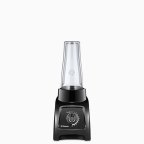 Recon S30
Recon S30  Recon 2-Speed
Recon 2-Speed  Recon 5200
Recon 5200  Recon 5300
Recon 5300  Recon Pro 500
Recon Pro 500 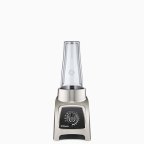 Recon S55
Recon S55  S30
S30  2-Speed
2-Speed 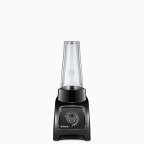 S50
S50  Recon 7500
Recon 7500  5200
5200  S55
S55 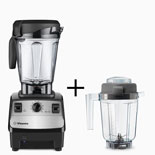 Recon 5300 + 32oz
Recon 5300 + 32oz  Recon Pro 750
Recon Pro 750  7500
7500  Pro 500
Pro 500  Recon 7500 + 32oz
Recon 7500 + 32oz  Pro 750
Pro 750 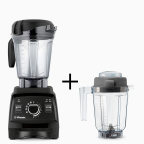 Recon Pro750+32oz
Recon Pro750+32oz  7500 + 32oz
7500 + 32oz  Pro 750 + 32oz
Pro 750 + 32oz  780
780 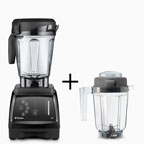 780 + 32oz
780 + 32oz(If you want the 32-oz container, you have to add it to your cart separately: 32-oz container link)
If you’re overwhelmed by the choices and just want to know my preference, I’ve used all of the different types of Vitamix blenders, and before I started using Ascent, the one I used on a daily basis was the 7500, with an extra 32-oz container for blending smaller amounts. (For the best deal, check out certified reconditioned.) All of the models are excellent, and I don’t think there is a wrong choice. (Plus, if you change your mind in the first 30 days, you can get a full refund, including free shipping both ways.)
Summary of Differences
These are the five key decisions to make when deciding which Vitamix to buy:
The following comparison chart shows the relations between the different machines in the S-Series, C-Series, and G-Series. The machines within most boxes of the chart are identical, but they come with different accessories and cookbooks (the exceptions are the S50 and S55, where the S55 has 2 more presets than the S50, and the Pro 750 and Vitamix 780, where the 780 has a flat touchpanel control). Generally the differences in accessories/cookbooks are pretty marginal, so I’d recommend going for the lowest price model within the box.

(“+” indicates there are also more expensive options in addition to the price listed in the chart. The following machines are not shown because they do not fit in with the rest: the Vitamix Turboblend Two Speed and Three Speed lack variable speed control, and the Vitamix 5300 and 6500 are a hybrid of the 6300 and 7500—i.e. they have a 7500 container on a 6300 base, without or with presets.)
Personal Blender? (S-Series vs. C-Series and G-Series)
(Vitamix S30 and S55 vs. 5200, 7500, et al.)
 In 2014 Vitamix released the Vitamix S30. It is smaller than the other Vitamix models, and also comes with a combination blending container/to-go smoothie cup. The Vitamix S50 and Vitamix S55 came out in 2015, and they are the same as the S30 but add preset modes. Since these models are significantly different from all the other models, I put up a detailed Vitamix S30 and S-Series review. If you are considering a smaller blender, or like the idea of blending in a to-go smoothie cup, you should check them out. Not surprisingly, the S-Series’ smaller size means that their maximum capacity is lower the other models (40 oz vs 64 oz).
In 2014 Vitamix released the Vitamix S30. It is smaller than the other Vitamix models, and also comes with a combination blending container/to-go smoothie cup. The Vitamix S50 and Vitamix S55 came out in 2015, and they are the same as the S30 but add preset modes. Since these models are significantly different from all the other models, I put up a detailed Vitamix S30 and S-Series review. If you are considering a smaller blender, or like the idea of blending in a to-go smoothie cup, you should check them out. Not surprisingly, the S-Series’ smaller size means that their maximum capacity is lower the other models (40 oz vs 64 oz).
Variable Speed?
(Vitamix Two Speed vs. 5200 and Vitamix 6000 vs. 6300)
 The variable speed control found on all Vitamix machines except for the Two Speed and 6000 is useful for when you don’t want to fully liquefy your blend. Examples are pesto, salsa, or chopping vegetables. If you don’t have variable speed, you can get away with quickly pulsing, but you won’t have quite as much control. The variable speed also makes the “bubble removal trick” more effective, although pulsing on low speed also works.
The variable speed control found on all Vitamix machines except for the Two Speed and 6000 is useful for when you don’t want to fully liquefy your blend. Examples are pesto, salsa, or chopping vegetables. If you don’t have variable speed, you can get away with quickly pulsing, but you won’t have quite as much control. The variable speed also makes the “bubble removal trick” more effective, although pulsing on low speed also works.
Preset Programs?
(Vitamix Two Speed vs. 6000, Vitamix 5200 vs. 6300, Vitamix Professional Series 200 vs. Professional Series 500, Vitamix S30 vs. S55, and Vitamix Professional Series 300 vs. Professional Series 750)
 The preset programs on the 6000, 6300/Pro 500, S55, and Pro 750 allow you to select a program, turn it on, and then the machine will automatically ramp up the speed and then shut off after a certain amount of time. There are a number of reasons that people appreciate this function:
The preset programs on the 6000, 6300/Pro 500, S55, and Pro 750 allow you to select a program, turn it on, and then the machine will automatically ramp up the speed and then shut off after a certain amount of time. There are a number of reasons that people appreciate this function:
• You can start the machine and “walk away” to do something else.
• If you strictly follow recipes the presets can yield more consistent results.
• Presets can give new users more confidence with the machine.
However, the presets do not work perfectly every time. Sometimes ingredients require tamping to start circulating past the blades, so you can’t always “walk away.” Also, the preset time might not be the optimum blending time if you modify a recipe. You may find that your smoothie is not fully blended after the smoothie program runs, so you have to run it again. A commercial coffee or smoothie shop makes the same recipes over and over, so in that setting presets are extremely useful. If you constantly make new combinations and of differing amounts, as many home users do, the settings may be less useful. It’s not too hard to tell when something is sufficiently blended, and after a few trials anyone should be able to figure it out. For these reasons, I personally would not pay extra for the preset settings. However, I know many people who have the presets love them. One thing to remember is that the machines with presets still have the variable speed knob for full manual control. If you don’t mind the added cost of presets, you can always switch back and forth to manual control.
C-Series vs. G-Series (Next Generation)?
(Vitamix 5200 vs. 7500, and Vitamix Professional Series 500 vs. Professional Series 750)
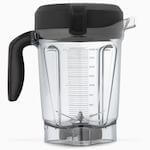 Vitamix released the “Next Generation,” aka “G-Series,” models in 2012. Both the base and the pitcher have an updated design. The base has slightly better sound muffling and also has better airflow which means that it can work harder before it overheats. To go with the better-cooled motor, the updated pitcher has a 4-inch blade instead of the Standard/Classic “C-Series” 3-inch blade. The 4-inch blade is in a shorter and wider container that has the same capacity as the 64-oz C-Series container.
Vitamix released the “Next Generation,” aka “G-Series,” models in 2012. Both the base and the pitcher have an updated design. The base has slightly better sound muffling and also has better airflow which means that it can work harder before it overheats. To go with the better-cooled motor, the updated pitcher has a 4-inch blade instead of the Standard/Classic “C-Series” 3-inch blade. The 4-inch blade is in a shorter and wider container that has the same capacity as the 64-oz C-Series container.
Advantages of the wider design:
• less need for the tamper (ingredients fall into the blades more easily)
• better chopping capability (you can course-chop more ingredients at a time)
• easier to scrape thick mixtures out
Advantage of shorter design:
• easier storage (at 17.5” tall, the container with lid on the base fits under standard kitchen cabinets)
Advantages of the 4-inch blade:
• faster processing time
• under some circumstances, marginally smoother blends
The one disadvantage of the new container is that for small volumes of under ~2 cups it does not work quite as well as the C-Series narrow container. The G-Series wider design causes two things to happen. First, there is more splashing up onto the inside of the lid and upper walls of the container, which means you lose a small amount of your blend unless you carefully scrape off the lid and walls. Second, you need slightly more volume to cover the blades and get good circulation going. The minimum volume to blend depends on what you are blending, and also on how much effort you are willing to spend pushing ingredients back into the blades. For example, for best results, the narrow containers can make nut butter easily by starting with 3 cups of nuts, whereas the wider Next Generation containers do best with 4 cups of nuts. For easier, more liquidy, blends, you can go below 1 cup in either container, but Next Generation containers will splash around more.
This disadvantage is a non-issue if most of your blends are over 2 cups, or if you are willing to spend a bit more to buy an additional narrow container, which will give you the best of both worlds. I like the 32-oz container for this purpose, although the 48-oz container has the same narrow bottom so it works just as well. The 48-oz container is just a bit bulkier on the outside because it sits outside the centering posts instead of inside of them, and its top is wider as well.
(The narrow C-Series Vitamix containers are compatible with G-Series models, but the G-Series containers are not recommended for use on C-Series models. The longer G-Series blades increase the load, and Vitamix does not recommend the C-Series cooling system for those increased loads.)
Reconditioned?
 Buying reconditioned is a great way to save money. For more details on deciding about buying reconditioned, see my refurbished Vitamix page.
Buying reconditioned is a great way to save money. For more details on deciding about buying reconditioned, see my refurbished Vitamix page.
Continue on for more details of each model type…
The array of different Vitamix blenders is a bit confusing, but it turns out that there is a lot of redundancy between the different models. I am only discussing models made for consumer/home use. Their commercial blenders are not ideal for home use because they are generally more expensive and have shorter warranties (3 years vs 7 years for home use; they are warrantied for constant use—think of how many times per day a blender at Jamba Juice runs compared to at your home).
The Vitamix website currently lists over 30 different home models, but they are all variants of three main designs: “personal” (S-Series), “standard/classic” (C-Series), and “next generation” (G-Series). For each of these main designs there are a few different options, to make a total of 8 different machine types. The rest of the models have identical bases, but come with different containers and/or accessories.
S-Series Motors
If the smaller size, dishwasher safe container, and “to-go” blending container appeal to you, please read the full details at my Vitamix S30, S50, and S55 review. For quick reference, the size of the base is 8.3″ deep x 5.9″ wide x 7.7″ tall. With the 20-oz to-go container the total height is 14.55″. The height is 15.66″ with the 40-oz container. These models have lower power, but they are still capable of making all of the usual Vitamix creations, just in smaller quantities.
C-Series Motors (Standard/Classic)
There are three types of bases of the standard variety. The differences are in the controls. The dimensions of the base of these machines are 8.75″ deep x 7.25″ wide x 8.25″ tall. There are three different container size options: 32 oz, 48 oz, and 64 oz, which result in height of base plus container/lid of 16.9″, 17.4″, and 20.5″ respectively.
Standard, no-variable speed (Vitamix TurboBlend Two Speed and Three Speed)
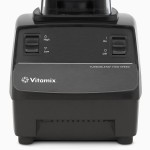 TurboBlend Two Speed (
TurboBlend Two Speed ($399$349); reconditioned for $299. This machine comes with a 5-year warranty and lacks the variable speed knob. Variable speed is useful for cases where you want to have finer control over the texture (i.e. if you don’t want a totally smooth purée). However, you can accomplish some non-liquefying chopping tasks by quickly pulsing the machine. While this is the most affordable new machine, I’d highly recommend looking at the reconditioned 5200, which has the same warranty and adds variable speed for $70 less.
In May 2016 Vitamix came out with a new no-variable speed machine, the TurboBlend Three Speed($499). It is exactly what it sounds like: it has three speed settings: low, medium, and high. It also has a pulse switch, which does the same thing as switching the start-stop button on and off. The pricing on this model is a bit strange, since for $50 less you can get a machine with fully variable speed. Plus, the TurboBlend 3-Speed comes with a 5-year warranty, instead of the 7 years on machines like the 5200.
Standard variable speed (Vitamix 5200 et al.)
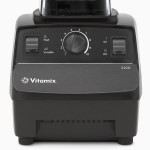 Until recently this was Vitamix’s bread and butter, and they have a lot of models to show for it: 5200 ($449), TurboBlend VS (retired), CIA Pro (retired), Pro 200 ($499), Creations II ($449), and Creations GC (retired); reconditioned for $329. These machines are essentially identical. Some are available with a shorter 48-oz container instead of the 64-oz container. The smaller container is nice because it’s more compact (and fits under standard kitchen cabinets), but of course its capacity is lower. The aesthetics of the switches and dial are slightly different between the different models. The Creations models come with a 5-year warranty, while the rest are 7 years. The 5200 comes with their “whole foods cookbook,” the TurboBlend VS comes with a vegetarian/vegan/raw cookbook and a nutmilk straining bag, the Pro models come with a cookbook with restaurant-oriented recipes (the CIA one—that’s Culinary Institute of America—comes with an additional recipe book). Note that if you buy reconditioned, you cannot choose which of the Standard models you are getting; Vitamix will choose for you based on availability, but remember that functionally they are identical.
Until recently this was Vitamix’s bread and butter, and they have a lot of models to show for it: 5200 ($449), TurboBlend VS (retired), CIA Pro (retired), Pro 200 ($499), Creations II ($449), and Creations GC (retired); reconditioned for $329. These machines are essentially identical. Some are available with a shorter 48-oz container instead of the 64-oz container. The smaller container is nice because it’s more compact (and fits under standard kitchen cabinets), but of course its capacity is lower. The aesthetics of the switches and dial are slightly different between the different models. The Creations models come with a 5-year warranty, while the rest are 7 years. The 5200 comes with their “whole foods cookbook,” the TurboBlend VS comes with a vegetarian/vegan/raw cookbook and a nutmilk straining bag, the Pro models come with a cookbook with restaurant-oriented recipes (the CIA one—that’s Culinary Institute of America—comes with an additional recipe book). Note that if you buy reconditioned, you cannot choose which of the Standard models you are getting; Vitamix will choose for you based on availability, but remember that functionally they are identical.
Sometimes these models are listed with their color-specific SKU. All of the following models are identical to the 5200, they just come with different colors and names: Vitamix 1709, 1363, 1364, 1365, 1709, 1723, 1732. They also sometimes go by VM0103. Vitamix 1978 is also the same, but comes with a 48-oz container.
Standard variable speed + presets (Vitamix 6300 and Professional Series 500)
 Pro 500 ($559) and 6300 (retired); reconditioned for $379. These are the same model; the only difference is that the 6300 comes with the “Savor” cookbook, which has a broader range of recipes than the Pro 500’s “Create” cookbook, which focuses more on restaurant-style recipes that tend to be richer.) They have 3 preset programs that run the blender for a certain amount of time and speed for smoothies, frozen desserts, and hot soups. Their switches are slightly different from the non-preset models. The non-preset models have an on-off switch, a variable speed knob, and a high-variable speed switch. The preset ones have moved the highest speed setting onto the knob and replaced the high-variable speed switch with a pulse switch. This is really a minor aesthetic difference, since you can achieve pulsing on the non-preset models by quickly flicking the on-off switch on and off.
Pro 500 ($559) and 6300 (retired); reconditioned for $379. These are the same model; the only difference is that the 6300 comes with the “Savor” cookbook, which has a broader range of recipes than the Pro 500’s “Create” cookbook, which focuses more on restaurant-style recipes that tend to be richer.) They have 3 preset programs that run the blender for a certain amount of time and speed for smoothies, frozen desserts, and hot soups. Their switches are slightly different from the non-preset models. The non-preset models have an on-off switch, a variable speed knob, and a high-variable speed switch. The preset ones have moved the highest speed setting onto the knob and replaced the high-variable speed switch with a pulse switch. This is really a minor aesthetic difference, since you can achieve pulsing on the non-preset models by quickly flicking the on-off switch on and off.
Some people love the presets because you can set it and walk away (assuming the mixture is circulating and you don’t need the tamper), and because they get more consistent results. However, the more consistent results will only hold if you always add the same quantities and types of items to the blender. For example, if you’re making a small smoothie, you can blend it for less time than if you were making a large one. One other thing is that you can set the non-preset machines and walk away—you just have to come back to stop them. I often use the blending time to rinse off the knife and cutting board that I used. You’re not likely to forget that the Vitamix is running because it’s loud enough to hear throughout the house. The variable speed knob goes to the same high speed as the previous models on high, but it’s lowest setting is a bit faster than on the 5200 et al., so you lose a tiny bit of fine control. Whether the presets are worth it is a personal question—I wouldn’t pay extra for them, but some people love them.
Standard no variable speed + presets (Vitamix 6000)
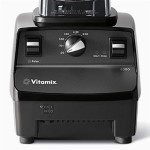 6000 (retired). Released October 2013, this is more of a mash-up of existing machines than a truly new one. It’s a sort of blend between the Two Speed, and the 6300. It does not have variable speed control, but it has six preset timed blending settings. These settings will automatically ramp up the speed, and then turn it off after a specified time of 20 sec, 30 sec, 1 min, 1.5 min, 4.5 min, or 6.5 min. Like the 6300, the pulse control is spring-loaded so that it only stays on as long as you hold it down, and it blends at a medium-low speed.
6000 (retired). Released October 2013, this is more of a mash-up of existing machines than a truly new one. It’s a sort of blend between the Two Speed, and the 6300. It does not have variable speed control, but it has six preset timed blending settings. These settings will automatically ramp up the speed, and then turn it off after a specified time of 20 sec, 30 sec, 1 min, 1.5 min, 4.5 min, or 6.5 min. Like the 6300, the pulse control is spring-loaded so that it only stays on as long as you hold it down, and it blends at a medium-low speed.
G-Series Motors (Next Generation)
In 2012 Vitamix released a new generation G-Series base with improved airflow that makes it run cooler and quieter than the classic C-Series one. With the improved cooling, the G-Series base can use a new pitcher design that is wider and has longer blades. This design makes the tamper less necessary, and makes it easier to get thick mixtures out. The longer blades also process food faster and work better for chopping. The G-Series machines are compatible with the C-Series containers, so if you want to use the dry blade you can use the same classic dry container. Dimensions are 9.4″ deep x 7.7″ wide x 17.5″ tall (with new-style 64-oz container in place). For more details of sizes, check out the PDF footprints I made for my Vitamix S30 review.
Next generation motor (Vitamix 7500, Professional Series 300, and Creations Elite)
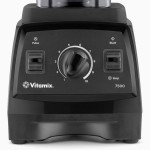 7500 ($529), Creations Elite ($557.50), and Pro 300 ($559); reconditioned for $439. These are all the same machine, so don’t worry about the note on the Reconditioned Next Gen page that says that the label may reflect any of these models. The only difference is the name printed on it. One point of confusion is that the Creations Elite is sold new with a smaller container, but if you happen to get sent a Creations Elite as a Reconditioned Next Gen, it will come with the same low profile 64-oz container that the 7500 comes with.
7500 ($529), Creations Elite ($557.50), and Pro 300 ($559); reconditioned for $439. These are all the same machine, so don’t worry about the note on the Reconditioned Next Gen page that says that the label may reflect any of these models. The only difference is the name printed on it. One point of confusion is that the Creations Elite is sold new with a smaller container, but if you happen to get sent a Creations Elite as a Reconditioned Next Gen, it will come with the same low profile 64-oz container that the 7500 comes with.
Next generation motor + presets (Vitamix Professional Series 750 and Vitamix 780)
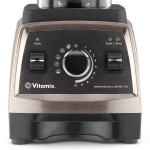
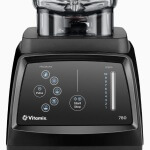 Pro 750 ($599–$649), 780 ($719); available reconditioned: 750 for
Pro 750 ($599–$649), 780 ($719); available reconditioned: 750 for $519–$569$499, and 780 for $519$399. These models have 5 presets: smoothies, frozen desserts, purées, hot soups, and self-washing. If you want to see more details of exactly what the presets do, check out my page about demystifying Vitamix presets. The 780 is identical, except that it has a touchpanel control interface. See my Vitamix 780 review for more details.
Vitamix Heritage 750 vs. Original 750?
In late 2015, Vitamix released a new version of the Pro 750: the Heritage line. The Vitamix Heritage 750 is functionally equivalent to the original Pro 750, but it has two differences on the exterior of the base. The upper shell (see diagram below) is now metal on the Heritage models. The Vitamix website doesn’t put Heritage in the model title, but it’s there in the description.
 The original 750 came in a brushed stainless finish option, but the upper shell was plastic with a thin metallic coat that could be scratched or scuffed. (When I tested the original 750 for a couple of months, I did not see any problems, but I have heard that some people have noticed scratches/scuffs.) The solid metal of the new Heritage models is more durable. Also, the metal shell muffles the the motor a bit more than the plastic, making the Heritage models a bit quieter.
The original 750 came in a brushed stainless finish option, but the upper shell was plastic with a thin metallic coat that could be scratched or scuffed. (When I tested the original 750 for a couple of months, I did not see any problems, but I have heard that some people have noticed scratches/scuffs.) The solid metal of the new Heritage models is more durable. Also, the metal shell muffles the the motor a bit more than the plastic, making the Heritage models a bit quieter.
 The other minor difference is that the Heritage models’ front panel has fewer backlights: Heritage models light up the indicators above the pulse and start-stop switches, whereas the original Pro 750 has backlights around the central knob as well.
The other minor difference is that the Heritage models’ front panel has fewer backlights: Heritage models light up the indicators above the pulse and start-stop switches, whereas the original Pro 750 has backlights around the central knob as well.
The Heritage metal is available in brushed stainless and copper finishes. (Currently on Vitamix.com, the Heritage options are listed on the main Pro 750 page, and the old brushed stainless finish is discontinued.)
I believe it is called Heritage because it is a throwback to the original Vitamix models that had all-metal bases. The plastic that Vitamix has been using for their bases for the past 25 years is extremely durable, so this change won’t affect functional longevity. That said, the elegant finish of the Heritage models will now likely stay unblemished for longer. It’s also nice that Vitamix did not increase the price for this upgrade.
The Vitamix 5300 and 6500
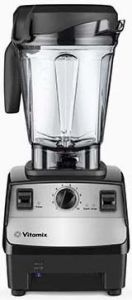 5300 ($529) and 6500 ($599); reconditioned for $360. Vitamix does not currently sell the new models online, only the reconditioned one. These are “new” models for 2015, although they are actually just slightly unexpected mash-ups of previous models. They are a hybrid between a 6300 and a 7500. They use the wide Next Gen (G-Series) container but they have a Classic (C-Series) base. The 5300 has variable speed and a pulse control switch, and has no presets. Meanwhile, the 6500 has the same three presets as the 6300. (Further evidence of equivalence between the 5300/6500 and C-Series models is on the Reconditioned C-Series 6300/Pro 500 page: it says its base may be a 6500.)
5300 ($529) and 6500 ($599); reconditioned for $360. Vitamix does not currently sell the new models online, only the reconditioned one. These are “new” models for 2015, although they are actually just slightly unexpected mash-ups of previous models. They are a hybrid between a 6300 and a 7500. They use the wide Next Gen (G-Series) container but they have a Classic (C-Series) base. The 5300 has variable speed and a pulse control switch, and has no presets. Meanwhile, the 6500 has the same three presets as the 6300. (Further evidence of equivalence between the 5300/6500 and C-Series models is on the Reconditioned C-Series 6300/Pro 500 page: it says its base may be a 6500.)
The reconditioned 5300 is the most affordable option for a machine with the short/wide container.
The strange thing about these models is that previously Vitamix stated that Next Gen containers should not be used on Classic bases because they do not have the updated airflow design that cools the motor more effectively.
I strongly suspect that the 5300 has the same microprocessor speed control as the 7500, Pro 750, and 6300, just without the presets. (You can read about the speed control of the different machines on my Vitamix RPM measurement page.) The microprocessor speed control should help protect the motor when using the wide container at high loads and very low speeds, but at maximum speed it shouldn’t make a difference. The marketing copy for the 5300 says that it comes “with a faster, yet quieter, motor,” but I am skeptical of those claims [Update: interestingly, Vitamix removed that phrase].
The 5300 and 6500 are a bit louder than the G-Series bases, which have sound-dampening technology not present in the C-Series bases. At the same price point, I would prefer the 7500.
Satisfaction Guarantee
Vitamix has a 30-day satisfaction guarantee, so if you have second thoughts you can return a machine within the first 30 days for a full refund and they even pay return shipping.
Warranty
If your machine has any problems during the warranty period of 5 or 7 years, Vitamix will repair or replace it, and they cover shipping costs both ways. For more details about warranties, check out my Vitamix Warranty page.
Reconditioned Vitamix
 I know I already mentioned reconditioned machines, but I want to restate what a great deal I think they are. These factory-refurbished machines offer the best prices you’ll find on Vitamix: 5200 for $329, Pro 500 for $379, and 7500 for $439. For more details, see my refurbished Vitamix page.
I know I already mentioned reconditioned machines, but I want to restate what a great deal I think they are. These factory-refurbished machines offer the best prices you’ll find on Vitamix: 5200 for $329, Pro 500 for $379, and 7500 for $439. For more details, see my refurbished Vitamix page.
Payment Plans
Want to start blending right away, but don’t want to pay the full price up front? Vitamix offers payment plans with zero interest and no fees if you make payments on time. For more information, check out my payment plan page.
Free Shipping
Clicking on any Vitamix link on this page will automatically apply a promotion code, which gives you free shipping on your order of a Vitamix machine (or anything else on Vitamix.com over $50) in the U.S. or Canada. For more details, see my page about the Vitamix promotion code.
Extra Bonus
If you order via a link on this site, Joy of Blending can get a commission. I deeply appreciate your support, and, to thank you, I want to help you get the most out of your new machine. I try to answer all questions from everyone, but sometimes I get swamped. If you order through one of my links, I will give you a private way to contact me so that I can answer your questions before visitors who are not on the special list. Please make sure my link is the last link you click before placing your Vitamix.com order. Then just forward your order confirmation to thanks@joyofblending.com.
Recommended Accessory
I highly recommend a spatula for getting the last bits of thick mixtures out of the container. For the narrow containers I recommend a long narrow spatula. For the wide containers, I recommend Vitamix’s under-blade scraper.
Dry Container
If you’re wondering if you should get a dry container, this new post is for you: Is the dry container worth it?
Phew… so that completes the Vitamix model round-up. I’m looking forward to getting back to describing some actual recipes!
Or follow along on Twitter or Facebook:

Thank you so much for taking the time to do this research and provide information.
And thank you for visiting, reading, and commenting!
Your summary and comparison was extremely helpful. Do all models serve as a food processor? Do all models and containers allow for orange peals, apple peals, cucumber peels etc.?
Thanks
Yes, all models can perform food processor tasks like chopping. One thing to note is that the G-Series models with the wider base allow you to chop more ingredients at a time, so that’s something to consider if you are thinking of using it for a lot of chopping.
And yes, all models will blend peels to a super fine consistency. However, I do not recommend blending orange peel, because it is super bitter. Apple and cucumber are fine though.
This was an amazing article! Thank you so much. It has helped me decide on a model.
Thanks for all the helpful info. I’ve wanted a Vitamix for years. I’m encouraged by the decrease in noise level as well as some of the other features.
One thing I haven’t seen addressed generally, not just here, is the decibel level of each machine and the effect it can have on hearing, especially children, who we are encouraging to eat more veggies and fruits by helping to make smoothies, etc. When running a blender, we may have a tendency to say “Oh it’s noisy” like that’s no big deal. Well it is a big deal. We take our ears for granted. Loud noise can be dangerous to children and infants and to adults as well. Hearing loss is gradual and doesn’t usually have symptoms.
I’d like to know the decibel levels of each machine front and center with each advertisement. I wonder if anyone has ever consulted an audiologist to ask about the effects of a blender so noisy that it can be heard throughout the house, or that people have to cover their ears to use, or tell their kids to cover their ears or leave the room or put it outside to use. Or have to spend extra money to buy a cover for the unit to reduce the noise. These are comments I’ve read about Vitamix and other blenders on several sites.
I have sensitive hearing and that’s why I’ve never bought a Vitamix, I use ear muff protectors when I run my vacuum cleaner, (and finally found a quiet paper shredder) so I can appreciate to some extent how sensitive children are to noise. (Sensitive hearing also allows me to hear beautiful sounds that others may not hear as clearly.)
Doesn’t make sense to me to give our kids healthy fruits and veggies and yet potentially damage their ears in the process. Noise pollution is dangerous and its effect on health is real, yet most people don’t think about it much because it’s not bothering them too much or just accept that’s just the way it is or maybe aren’t aware of it.
I hope more moms make their voices heard about this. Consumers do have power. I probably should be writing this to Vitamix and the other companies but for some reason I landed here.
Please don’t take this personally. I didn’t intend to write all of this, but obviously I feel passionate about it and just wanted to bring some awareness.
Hi Joann,
I am also sensitive to loud sound. I use earmuffs when blending (and I’ve started wearing them for vacuuming and weed whacking as well). I wrote about the earmuffs I use back when I started this blog. If you want to use a noisy blender with kids, you could get kid-size earmuffs. As far as hearing the blender throughout the house, it is audible, but the sound is greatly reduced with distance, so I wouldn’t be concerned about sound exposure in other rooms.
There are sound enclosures for blenders, but most home users do not get them because they are bulky and a bit on the expensive side.
I can think of a few reasons that decibel levels are not advertised more prominently. First, many people do not really understand decibels. Second, given the short duration that a Vitamix actually runs, the maximum sound level is far below established hearing danger thresholds. And third, the actual sound level will change significantly depending on distance to the blender, as well as the shape, size, and materials of the surrounding environment.
A post of decibel measurements is on my to-do list, but I have not gotten to it yet.
Thanks for your thoughtful reply. I think bottom line I’m bothered that we as consumers have to do all this extra stuff-earmuffs, don’t run machine too long, (how long is too long? I don’t know enough about it.) buy expensive enclosures, etc. It shouldn’t have to be that way. That responsibility should be on manufacturers as part of the design, and not just for blenders, but also vacuum cleaners, hair dryers, etc. I don’t know if a little bit of loud noise here and a little bit there has a cumulative effect on hearing. I guess changes aren’t always made unless consumers complain and enough become aware and make their voices heard.
I’ll look forward to reading about decibels.
I wear the Hearos brand earplugs while using my blender, sleeping, flying. I find them very comfortable and effective…hope this tip is helpful to someone! They are available at local drugstores such as CVS and Walgreeen’s.
I love this comparison.Enormous help with the decision,thanks a lot !
Glad to hear it was helpful!
My husband and I have jumped, whole-heartedly into the “Trim Healthy Mama” (or Papa!) lifestyle, and use a blender at least once a day. Ours 30+ year old one appears to be nearing the end, and I’ve heard so much about the Vitamix, but until reading the details of your research, really had no clue as to where to start in comparisons…of Vitamix, or any other. THANK-YOU!!!
Thanks for all the great information. It has helped in narrowing my decision between the 7500 & Pro 750.
One question. You stated both the 7500 & Pro 750 have 4″ blades. When I was looking at the Product Specifications on the Vitamix web site, it showed the Pro 750 has 4″ blades but the 7500 specifications show the blades are 7.6-cm diameter. The 7.6 cm converts to 3″ (there are 2.54 cm in an inch). Is this an error on the 7500 Produce Specifications or does the 7500 64-oz low profile container actually have 3″ blades?
Thanks.
Yes, that is a mistake on the Vitamix website. The 7500 and the Pro 750 use the same container with 4-inch blades. It looks like that mistake is newish—I hadn’t seen it before. Also weird that they are listing blade length in cm, when the other dimensions are given in inches….
Oh my goodness,Thank you, this was EXACTLY the information I was looking for. I have been vacillating between a food processor or a blender, Vitamix vs Blend-tec and it is mind boggling. The only thing I was hoping for was the decibel levels on the various products. Youtube videos have such poor sound quality that they are no help.
That being said, I am so happy my research brought me to your site, it was extremely helpful.
This is a very good comparison of the many Vita-Mix models. However, there is a big disadvantage to the shorter, wider containers. They do not blend semi-solid mixtures near as well as the slender, tall 64oz container. We make lots of nut butters and Protein Shake Ice Cream and discovered this because friends with different containers were having trouble getting a smooth, thorough blend. We then tested it. If a mixture normally requires a tamper, you are better off with the tall slender 64ox than the 32oz, 48oz or new squat 48oz containers.
I believe there are two potential issues at play here. 1) The wide 64-oz container requires larger volumes to blend well because the same volume of ingredients does not go as high in the container with respect to the blades. I discuss this at greater length above in the section on C-Series vs. G-Series. I use the 7500 regularly with the wide 64-oz container, but I use the 32-oz container for blending smaller amounts. When I make thick things like hummus, nut butter, or sorbet, I almost always use the 32-oz container, so I don’t have tons of experience with blending thick blends in the wide container. I have tested it to confirm that it works though. 2) An issue I have noticed is that if I’m making a thick smoothie in the wide container and then throw in a hard ingredient (like an ice cube or frozen strawberry) toward the end of blending, there is a chance that it won’t get completely blended in the short amount of time that it would have in one of the narrow containers. However, in my experience, given a little more time, such chunks get fully blended.
Very helpful review. I’m going for a 7500. Are the 48ounce and the 32ounce containers built as stout as the low profile 64oz container that comes with the unit?? I’ve been told that they are in fact lighter weight designs esp. around the crucial base portion, but????? For one person smoothies, any reason you would advise the 32oz or the 48oz over the other?? Much appreciate your help. I don’t understand why a company that makes a great product insists on such a mess of, often misleading, technical specifications!
The 32 and 48-oz containers are every bit as solid as the low profile 64-oz container. They are just narrower at the bottom, which is what makes them better for blending smaller amounts. For anyone who also has a 64-oz container, I generally recommend the 32-oz container over the 48-oz container because it is just a bit more compact, which I find makes it more convenient. Blending quality between the 32 and 48-oz containers is the same, as are the minimum required blend volumes. If you need to blend more than 32 oz, then you can use the 64-oz container. (For someone who does not have a 64-oz container, I would usually recommend the 48-oz container over the 32 because that gives more flexibility in how much you can blend.)
Thank you for the clear comparison. I am yet deciding between the 300 and 750 within the G Series. Could the 300 do self-cleaning too without the preset program?
Secondly, would a Vitamix bought in the US be suitable for use in the UK with a converter? Will it affect the performance?
Yes, the non-preset models can still do self-cleaning—it’s just that they won’t turn off automatically.
You can use a US Vitamix abroad with a transformer, but you have to make sure it is a good transformer. Cheap or under-spec’d ones can damage the machine. I’ve heard that 2000 watts is sufficient, although I’ve also heard that Vitamix voids the warranty if you use your machine with a transformer.
Great review! How about the Aspire? To what model is it comparable to?
The Aspire is more or less the Canadian version of the Creations line. That is, it is a C-Series machine, like the 5200, except it is generally marketed for sale on The Shopping Channel. Like the Creations line, Aspire models have a 5-year warranty instead of the 7-year warranty on other new models.
what is the difference between the 300 and 7500. it looks like you are saying that they are the same but isn’t that silly? Is it really just color option and recipe book?
thanks much
That’s right (and I agree it’s a bit silly). The differences between the Pro 300 and 7500 are the color options, recipe book, and name. The main reason for the different names is Vitamix likes to target them to different types of customers and/or stores.
I’m considering a NutriNinja 1500 professional blender to make smoothies. I use a Jack LaLane jucinater and my favorite mix is apples, carrots and celery. It’s a hassle and clean up time is ridiculous. Now I’m looking at a Vitamix 7500. I would appreciate your input . Thank you
The Ninja would save you some money, but it is an inferior machine.
You mention the hassle of cleaning up your juicer—a Vitamix is less of a hassle to clean than a Ninja because the blades stay in the bottom, and you do not have to take them out for cleaning.
And speaking of the Ninja blades, they present a cutting hazard (not bad if you’re careful, but you don’t have to worry about that with a Vitamix). And the Ninja blades rely more on their sharpness for cutting compared to a Vitamix, which means that they dull faster and performance of the Ninja degrades over time.
Another downside to the Ninja is its non-vented lid, which means you can’t blend hot soups or beverages. The Ninja also has a shorter warranty, a cheaper feel to the materials, and worse customer service.
If you want to save money, I recommend buying a certified reconditioned Vitamix.
I do NOT recommend a Ninja blender. I currently have the Vitamix 300, which is comparable to the vitamix 7500. There is in no way the Ninja is superior to the Vitamix. I burned through two Ninja blenders in less than a year and a half. The Ninja left celery strings, and seeds in my smoothies, and that just does not happen in the Vitamix. Soups are hot and delicious! I can even make ice cream!! Cleaning is so simple with just a drop of liquid dish detergent, and less than 30 seconds on high. I have used customer service when
my dog swiped the cap off the counter and used it for a chew toy. They were very professional, and replaced the cap and the cover free (they come packaged together) right away! In my opinion, customer service is outstanding! I will most likely own my Vitamix for many years and hope to pass it down to family members when I am no longer on this earth! I’ve owned my machine for 2 years.
I am leaning towards the 7500 but am interested in also getting the 32 oz container…. but I also wanted the dry grains container (I bake a lot and currently I get my flour ground by my mom who has a grain mill)! That seems like a lot of containers. I read that you don’t think the dry container is 100% necessary. Would it be reasonable to just go with the 64oz that comes with the 7500 + a regular 32oz that I also use for grinding grain? Or would you go with all 3?
Thanks for sharing all this Vitamix info, it is really overwhelming to try to figure out the differences between all the blenders on the Vitamix website.
All three containers would be the optimum. That’s what I have, and it sounds like it would be a good fit for you as well. For a very limited time you can pick up a dry container for $50: Vitamix dry container on sale.
Thanks for the advice.
Go with all 3!!
I have all three, and I am really happy that I bit the bullet and did it. I use the big one for drinks for multiple people and also for soup and such. I use the 32 oz. wet for smaller servings of drinks (e.g. just me and/or me and my husband) as well as for salad dressings, nectar for the hummingbird feeder, marinades, brines, etc. And of course the dry container I use for making flours…I do hard wheat, soft wheat, buckwheat, rye, oat, rice, and pretty much any other grain I can get my hands on!
Thanks for sharing your experience Becky! 🙂
hi I have been reading your reviews to help make my decision.didnt think this would be so hard. trying to decide between 5200 and 7500 for a family of 2 adults and 2 kids. not sure if will be making smoothies for all every day. concerned about the volume needed in the 5200. is it 2 cups total of fruit and liquid. or 2 cups of liquid only.
sorry I meant to say I’m concerned about the size of blending jobs in the 7500 but I do want the newer, quieter, shorter model over the classic. just dont want to over spend on a blender thats already so pricey.
It really depends on what you are blending—2 cups is not a hard cutoff for the wide 4″ blade containers. And you can usually eventually get it to blend even down to 1 cup if you put in the effort. These volumes I’m talking about are volume of blended product (after fruit and liquid are blended). As mentioned above, if you want the ultimate, go with the 7500 plus an extra 32-oz container. If you won’t frequently blend small volumes, you can skip the small container. And if you want to save some cash, go for the 5200.
We just gave away our VitaPrep. We now have the 750 Pro Series with the pre-sets.
O M G we LOVE it.
We use it everyday.
Smoothies
Ice cream
Salad dressing
Fancy butters
Sauces
veggie chopper
You name it… It’s lovely.
My kids are no longer Erving up the motor for too long because of the pre-sets.
We have gadca vitamix now for 11 years!!!
Do you know anything about the specks of Teflon people are talking about on the 7500 Amazon reviews? It sounds a bit disturbing for such a pricy machine and I would really like to get one… With the 3 jars as recommended above.
I investigated, and found that if you look for the specks under the right conditions, there is a high chance of finding specks in current new containers, although in tiny quantities. From what I’ve read, the specks are harmless, since their material is non-reactive/inert. Vitamix is aware of customers’ unease with the specks, and they have said that they are working on rolling out a speck-free version. If you find specks and they bother you, Vitamix will replace your container.
Hi I just wanted to say thank you for your hard work in preparing this post and your advice. I live in the UK and am on the market fir a vitamix. Some things may be slightly different here but your advice has been invaluable.
is it possible to use the ‘to-go’ cups on a c-series or g-series vitamix?
thanks
No, the to-go cup can only be used on the S-Series models. You can of course blend in a C-Series or G-Series model and then pour into the to-go cup to take with you, but you cannot fit the to-go cup onto the base of a C or G-Series model.
thanks!